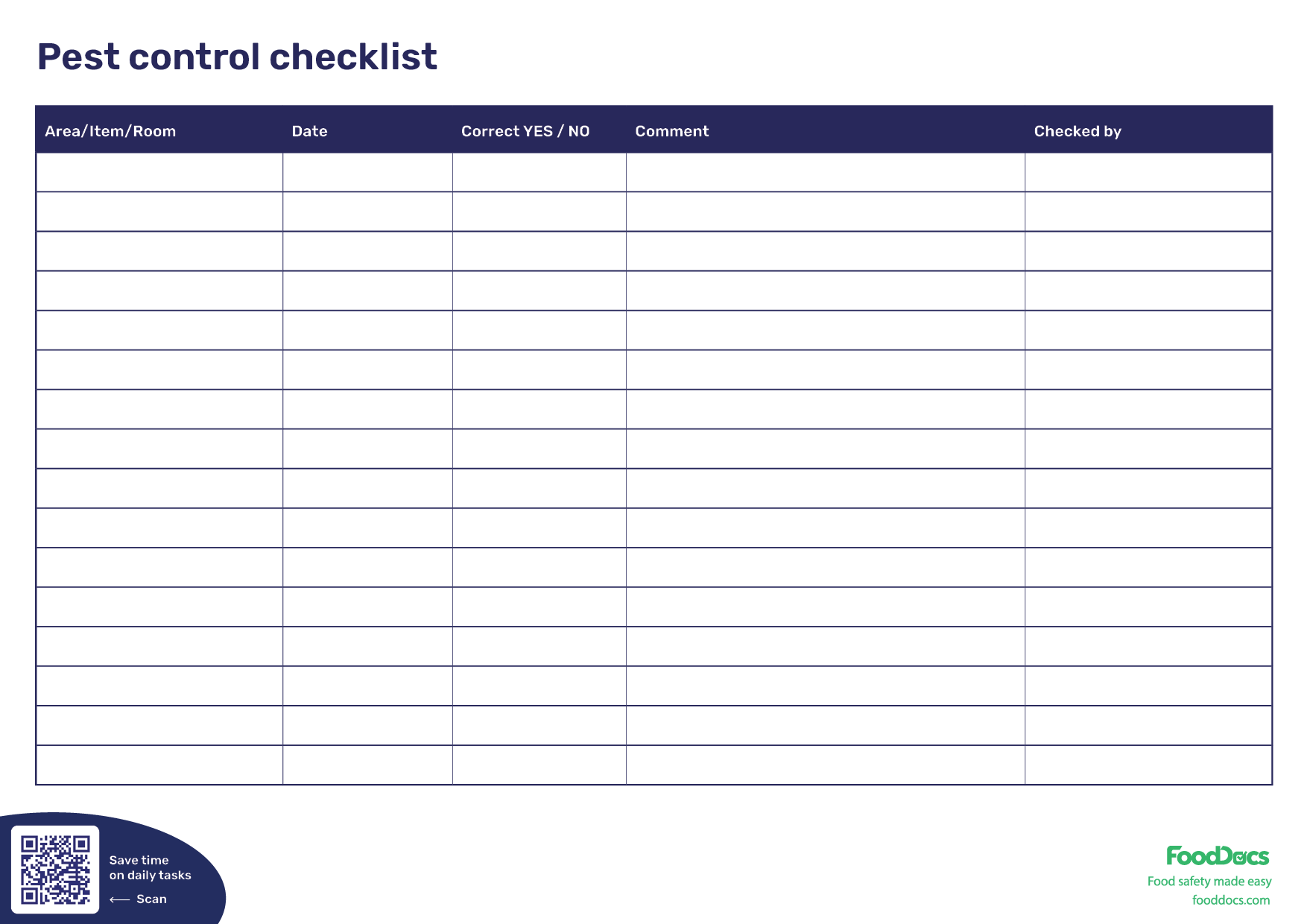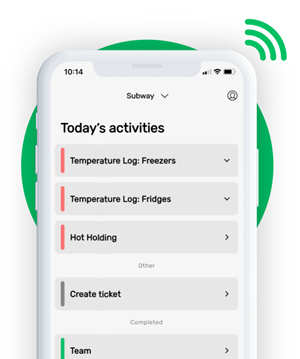PEST CONTROL CHECKLIST TEMPLATE


This is how our Digital Food Safety platform saves 20% of your time on daily tasks:
- Get upcoming task notifications
- Add data into the app
- Check the status of tasks in real-time

When food safety was still handled on paper, I typically spent a couple of hours per day getting the papers and going around checking or completing tasks… Now I can sit down and it's just all there in one place. It takes me 5-10 minutes.
Ruth B.
Store Manager
What is a pest control checklist?
A pest control checklist is an important food safety checklist that assists you when completing a periodic pest control inspection. Your inspection plan and period are set in your Pest Management Plan. You can find all the needed HACCP plan examples from our free food safety templates hub.
For food businesses, weekly and monthly pest control inspections are common, but some companies with higher risk inspect even more frequently. These inspections should focus on areas where pests are most likely to appear: receiving docks, storage areas, wardrobes, break rooms, sites of recent ingredient spills, etc.
Use this pest control checklist during your pest control inspection to identify or look for signs of pest activity in the property and determine whether these areas need treatment.
Key takeaways
-
Pest control is legally required for food businesses under U.S. and U.K. food safety laws to prevent contamination and protect public health.
-
The FDA Food Code and FSMA require restaurants in the U.S. to take preventive measures against pests as part of their food safety plan.
-
In the U.K., the Food Safety Act 1990 and Food Hygiene Regulations 2006 mandate businesses to protect food from pest access and harborage.
-
Integrated Pest Management (IPM) is the preferred strategy for controlling pests by focusing on prevention, sanitation, and minimal chemical use.
-
A proper pest control checklist should include daily, weekly, and monthly tasks such as cleaning, inspecting traps, and sealing entry points.
-
Common pests in restaurants include rodents, cockroaches, flies, ants, and stored-product insects, each with distinct signs of infestation.
-
Failing to comply with pest control laws can result in fines, shutdowns, or prosecution in both the U.S. and U.K.
-
Pest infestations can severely damage a restaurant’s reputation and are a common reason for health code violations and closures.
-
Regular staff training and inspections are essential to detect pest issues early and maintain compliance with food safety standards.
-
Food safety management software such as FoodDocs give foodservice teams digital checklists that enable real-time logging, reminders, and tracking of pest issues over time.
How to use our pest control checklist template
Maximize its use by implementing the following tips:
- Conduct visual pest control inspection around all rooms and areas on your premise
- Mark the date of the inspection.
- Mark if everything is correct or not.
- Take notes in the comment section of any issues found during the inspection. Also, add the corrective action taken.
- Add your name and signature to the report.

To make the most of the template, train your staff to use it during their routine opening and closing checks. Add pest sightings, signs of damage, or any actions taken. Digital checklists can help you track trends over time and send reminders so nothing is missed.
Save all your pest control inspection checklists with your other HACCP plan documents and all other food safety checklists. Your pest control documents have to be ready for the food safety audit at any time.
Sample pest control table (pests, signs, and prevention)
Here's a quick reference table to help your team identify pests and take action:
| Pest | Signs of infestation | How to prevent it |
|---|---|---|
| Rodents | Droppings, gnawed packages, grease marks | Seal cracks, keep food in containers, use traps |
| Cockroaches | Droppings, egg casings, musty smell | Clean spills, fix leaks, remove clutter |
| Flies | Larvae near drains, adult flies by food | Install screens, empty trash daily, clean drains |
| Ants | Visible trails, ants in sugary food areas | Store sweets securely, seal entry points |
| Pantry pests | Webbing or larvae in flour, grains, or rice | Store dry goods in sealed bins, inspect deliveries |
Why does pest control matter for restaurants?
Pest control matters for restaurants because pests can carry harmful bacteria and spread foodborne illnesses that put your customers and business at risk. Common infestations have been linked to serious outbreaks, fines, and even shutdowns.
Regular inspections and good housekeeping help prevent pests from entering or staying in your facility. A pest control checklist helps you document these tasks and catch issues early, before they turn into bigger problems.
What should a pest control checklist include?
Your pest control checklist should include routine tasks, inspection notes, and follow-up actions. Here's a breakdown of common items to include:
Daily pest control tasks
- Inspect floors, storage areas, and equipment for signs of pest activity
- Remove all food debris and clean under sinks, ovens, and fryers
- Take out garbage and clean trash bins with soap and hot water
- Check for and clean up any standing water in drains or under equipment
Weekly pest control tasks
- Replace or inspect sticky traps and bait stations
- Clean under large equipment and shelving units
- Sanitize trash bins, recycling areas, and outside dumpsters
- Look for cracks or holes in floors, walls, and doors that could let pests in
Monthly pest control tasks
- Deep clean floors, drains, vents, and hood systems
- Review pest control reports or logs from professional services
- Reassess sanitation practices with your team and provide refresher training
- Conduct a walk-through to identify high-risk areas or recurring issues
What are the most common pests in restaurants? (And what to look for)
Different pests cause different problems. Knowing what to look for can help your team take action quickly.
- Rodents: Droppings, gnaw marks on packaging, grease trails along walls
- Cockroaches: Pepper-like droppings, egg casings, live sightings in dark areas
- Flies: Buzzing near food or drains, larvae in garbage or spills
- Ants: Trails near food prep or sugary areas, tiny nests in cracks or behind walls
- Stored product pests: Webbing or larvae inside grains, flour, or dry food containers
Train your team to report signs of pests right away. Early detection helps prevent bigger infestations.
What are the basics of integrated pest management?
Integrated Pest Management (IPM) is a proactive way to control pests using preventive methods first. IPM combines daily practices with minimal use of chemicals. Here are the key parts:
- Inspection: Check areas where pests may enter, hide, or feed
- Sanitation: Keep all areas clean and remove food and water sources
- Exclusion: Seal entry points like cracks, holes, or gaps in doors
- Monitoring: Use traps and visual checks to catch problems early
- Control: Use targeted pesticides only if needed, following safety guidelines
Many food safety laws recommend or require IPM. It is more sustainable and often more effective than relying only on chemicals.
What do food safety laws say about pest control?
Pest control is not just a best practice in the food industry; it's a legal requirement. Both U.S. and U.K. food safety laws mandate proactive measures to prevent pest infestations in food establishments.
Pest control in the United States
In the U.S., the Food Safety Modernization Act (FSMA) emphasizes a preventive approach to food safety. Under FSMA compiance, food facilities are required to develop and implement a written food safety plan that includes hazard analysis and risk-based preventive controls. This plan must address potential hazards, including those posed by pests, and outline measures to prevent contamination.
Additionally, the FDA Food Code serves as a model for state and local regulations. It stipulates that food establishments must take effective measures to exclude pests from their premises. This includes maintaining the facility to prevent pest entry and harborage.
Pest control in the United Kingdom
In the U.K., the Food Safety Act 1990 requires food businesses to ensure that food is safe for consumption and free from contamination. This includes implementing measures to prevent pest infestations.
Furthermore, the Food Hygiene Regulations 2006 mandate that food premises be kept clean and maintained in good repair and condition. This includes protecting against the accumulation of dirt, contact with toxic materials, and pest access and harborage.
Importance of compliance
Non-compliance with these regulations can have serious consequences. In the U.S., violations can lead to warnings, fines, or even closure of the establishment. In the U.K., failure to comply can result in enforcement actions, including improvement notices, prohibition orders, and prosecution.
Implementing a robust pest control program not only ensures compliance with legal requirements but also protects your customers and your business reputation. Regular inspections, staff training, and proper documentation are key components of an effective pest management strategy.
Try digitizing your pest control checklist and other pest management tasks with FoodDocs
FoodDocs digitizes food safety for every critical area of a food business Monitoring, Traceability, and HACCP systems (as well as any other compliance standards due to the software's full customizability) — including pest control.
It allows food businesses to quickly create pest control-related checklists and easily assign specific team members to each task for maximum efficiency.
Food handlers must regularly remember when to check baits, replenish traps, and report any sighting of infestation signs. Our Food Safety Management software helps teams remember not only how to complete these tasks, but when they need to be completed. Start your 14-day free trial!
Frequently asked questions about pest control
How often should pest control be done in a restaurant?
Most restaurants use professional pest control services monthly or twice a month. In between, staff should use a checklist to do daily and weekly inspections.
What pests should a restaurant look out for?
Common pests include rodents, cockroaches, flies, ants, and pantry pests. Each can bring health risks and damage your reputation.
What are signs of a pest problem?
Look for droppings, gnawed food packages, grease marks, foul odors, insect sightings, or webbing inside dry food products.
Do restaurants need pest control by law?
Yes. Both U.S. and U.K. food safety laws require food businesses to prevent pests. Inspections often include a review of your pest control records.
What is IPM and why should I use it?
Integrated Pest Management is a safe and effective way to prevent pests. It focuses on keeping your restaurant clean and sealed up before using any chemicals.















